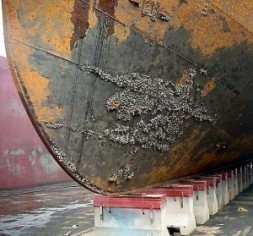 Ships may soon be able to shed the unwanted accumulation of bacteria and other marine growth with the flick of a switch.
Ships may soon be able to shed the unwanted accumulation of bacteria and other marine growth with the flick of a switch.
Researchers have developed a new material that can be applied like a paint to a ship’s hull and has the ability to wrinkle in order to dislodge bacteria. Lab results suggest a potential to prevent marine biofouling and so improve ship energy efficiency.
Keeping bacteria from attaching to hulls can prevent a larger cascade of events that can damage efficiency. Once bacteria have taken up residence on a surface, they often attract larger organisms, such as seaweed and the larvae of other marine organisms, such as worms, bivalves, barnacles or mussels. These organisms can increase the resistance of the hull as it moves through the water and lower the energy efficiency of the ship.
‘It is known that bacterial films can recruit other organisms, so stopping the accumulation process from the beginning in the first place would make a lot of sense,’ said Gabriel López, Professor of Biomedical Engineering and Mechanical Engineering and Materials Science at Duke University
The new material, designed by Duke University engineers, is said to work by physically moving at the microscopic level, thereby removing the bacteria without use of toxic chemicals.
“We have developed a material that “wrinkles”, or changes its surface in response to a stimulus, such as stretching or pressure or electricity,” said Duke engineer Xuanhe Zhao, assistant professor in Duke’s Pratt School of Engineering.
“This deformation can effectively detach biofilms and other organisms that have accumulated on the surface.”
“Nature has offered many solutions to deal with this build-up of biological materials that we as engineers can try to recreate,” said Lopez.
“For example, the hair-like structures known as cilia can move foreign particles from the lungs and respiratory tract,” Lopez said in a statement.
“In the same manner, these types of structures are used by molluscs and corals to keep their surfaces clean. To date, however, it is been difficult to reproduce the cilia, but controlling the surface of a material could achieve the same result.”
The researchers tested their approach in the laboratory with simulated seawater, as well as on barnacles. The results of the Duke studies were published online in the journal Advanced Materials.
For more tips and news on efficient shipping, please visit Fathom C-Tech

 Join The Club
Join The Club











